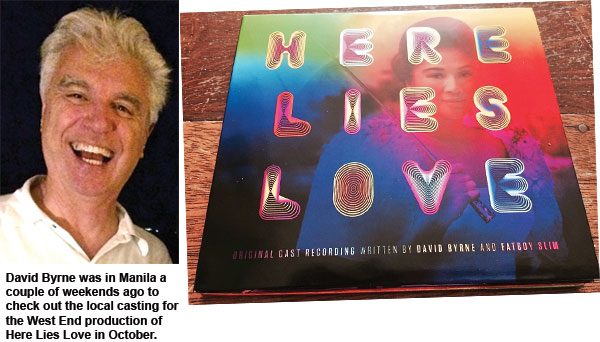Here lies complicity

Pure coincidence.
On the week that Imelda Marcos celebrated her 85th birthday, was photographed kissing the glass encasement of her husband’s crypt in Batac (some photo angles showed her kissing her own reflected image, of course), and raised yet another flap over her attendance at an Ateneo appreciation activity, where an unfortunate photograph of her with Ateneo scholars making the KBL victory sign went viral — who would blow into town but the music legend David Byrne, author of Here Lies Love, a highly successful music album and now theater piece featuring Imelda as the central figure.
Six years after we first met at a friend’s apartment in Malate when David first visited to begin his album research, we met him again at the same place, at a small party hosted by Butch Perez, with a score of other friends welcoming him back to Manila — Jessica Zafra, Apa Ongpin, Tad Ermitaño, Wawi Navarroza, Marta Lovina, Louie Llamado, Pandy Aviado, among others.
David was amused at hearing how he had barely missed his infamous subject’s 85th. He hadn’t known. He would be here for only three days, to look into the casting call procedure for the West End production of Here Lies Love by October — with the inevitable corps of Filipino musical talents.

Handing me a copy of the latest edition of the twin-CD album, he said it had evolved considerably from its first release as a musical collaboration between him and Fatboy Slim.
I have since enjoyed playing and replaying the 26 tracks that tell a jaunty narrative with inspired text, hum-stirring melodies and infectious beats.
The album notes prove invaluable. Byrne recalls the project’s development with a detailed piece, “The Road to the Stage: How did we get here?”
“About six years ago I had all but given up on this project ever being realized in a theatrical version when I heard that Oskar Eustis at the Public Theater in NYC might be interested.
“… I had always envisioned the piece taking place in a simulated club setting (Imelda liked discos; she installed a mirror ball in her NYC apartment), so when we met I made that clear — it shouldn’t, in my opinion, be presented as a proscenium piece.”
It took three years to mount in an unconventional manner — on moving platform/stages, with choreography, video, actual docu clips — after several workshops were conducted upon Eustis’ suggestion, and with director Alex Timbers and most other collaborators getting an important word in.
Ever humble and open-minded, Byrne realized he had to drop some of the original numbers and create new ones for a tighter, clearer storyline that would also lend itself better for a venue where the audience participates, at least in the disco dancing.
Oskar Eustis, artistic director of the Public Theater, weighs in with his own recollection:
“David Byrne came to see me at the Public Theater in the fall of 2009 with a collection of songs about Imelda Marcos, collectively entitled Here Lies Love. He was releasing them as a CD, and was interested in turning them into a live theater piece.
“I had been a fan of David’s since the mid-1970s when, as a teenage transplant from the midwest, I had seen the Talking Heads play at CBGB. He was also a familiar figure from the downtown performance scene — indeed, as we discussed directors who might be right for this show, I was surprised to discover that he knew the work of every director whose name I mentioned. His curiosity, his extraordinary mix of anxiety and exuberance, his sharp wit, his remarkable inventiveness — all were immensely appealing qualities.
“… David has described his excitement at finding a subject in Imelda Marcos, a ‘star who came with her own soundtrack.’ Her love for club music became the formal basis for a song cycle about her rise and fall. That form also perfectly captured the content David was excited by: the bubble that celebrity creates and the artificial world that the powerful can form around themselves. That bubble, that mirror-filled space of power, is where she both lives and the cause of her fall.
“… The Filipino cast members of Here Lies Love, these indispensble collaborators in making the show, have told us how much this story, their story, means to them. The People Power Revolution became, in many ways, the prototype for a wave of uprisings in the following quarter-century — the tearing down of the Berlin Wall, the Velvet Revolution, the Arab Spring — all the moments where it became clear that the people are the real source of legitimacy and power, in any nation.
“We may begin Here Lies Love thinking we are in Imelda’s disco — indeed, the show asks us to feel complicit in her rise to power. But by the end, we realize that Imelda just tried to take over the club for a while, and failed. This is the Filipino people’s party, and always has been.”
Twenty-six tracks tell the story, beginning and ending with “Here Lies Love”:
“Though I’m just a young girl from Leyte/ whose dresses are all/ hand-me-downs and scraps/ I’d see the people smile,/ when I would sing for them/ How happy they all seem/ when I would dance// The most important things are/ love and beauty/ It doesn’t matter if you’re rich or poor/ To prosper and to fly, a basic human right/ The feeling in your heart that you’re secure// Is it a sin to love too much?/ Is it a sin to care?/ I do it all for you—how can it be unfair?/ I know that when my number’s up/ When I am called by God above/ Don’t have my name inscribed into the stone… Just say/ Here lies love, here lies love, here lies love.”
The pop-mold songwriting ramps up the narrative, inclusive of a fictional character device in the form of Estrella, who’s made out to be a childhood friend of Imelda who turns into her devoted maid, yet also reminds her, sometimes painfully, of her origins.
Ninoy Aquino’s character is introduced. Here some liberties are taken, with his reported early date with Imelda lofted into fable, as she eventually recollects in a latter song how he had been “her first love.”
Enters the prideful, ambitious, dashing Ferdinand Marcos, whose courtship of Eleven Days leads to conjugal history, from Pygmalion episode to complementary, high-powered couple — through songs such as Sugartime Baby, Walk Like a Woman, Don’t You Agree?/Pretty Face (now joined together, on the director’s suggestion), and Dancing Together — with the last establishing Imelda as the jet-setting disco queen and blitz shopper who namedrops Margot Fonteyn, Charles Jourdan, Oleg Cassini, Andy Warhol, Hannae Mori…
When Imeda finds out about Dovie Beams, her duet with a pleading Marcos crackles with vernacular cutesy curse: “P*tang ina mo! You deserve to be sick!/ In public no less — what you did to me!/ How can a t*ti mo run the country? / It takes a woman to do a man’s job/…
And so she gains more power, as Marcos gets sicker, even as his Press Attachés sing a chorus: “The President’s fine — it’s a slight allergy/ Well he’s doing OK — you know he’s writing a book/ Our Presdent’s fine — it’s just a small cold/ Now, our President’s fine — you now he’s so overworked.”
Meldy goes more international, as the “bag lady.” She sings Poor Me: “The world — they want — to criticize us/ Greed, injustice and dominance/ A woman — a woman knows — knows relationships/ That’s why, why I make/ make my little trips…// Ronald Reagan, Mao Zedong —/ they’re all the same/ Kissinger, Anwar Sadat — let me explain/ First we talk a bit, a little dance — champagne on ice/ An hour or two, relationship — we’re friends for life!// Please don’t!/ Don’t let them look down on us/ Please don’t! Like they used to do to me// Nixon. Castro, Zhou Enlai/ Qaddafi is easy, and I’ll tell you why/ A woman knows, just how to do —/ only rub his leg/ He understood my point of view/ so I don’t have to beg!”
The rest of the tracks course through martial law and on to Edsa Uno: “Order 1081”; the Seven Years that Ninoy spent in prison; Gate 37 of that fateful day when he falls on the tarmac; Just Ask the Flowers as sung by Ninoy’s mother (“Now I watch the procession/ as his body goes by/ Half the country is here,/ but they won’t see me cry/ … Yeah, just ask the flowers, ‘Tama na, sobra na’…”), and recalls how as a boy he wanted to be a drummer (“I got to call the people, Mom—/ and get ’em all together/ I wanna be a drummer, Mom/…”)…
Byrne writes: “I wanted to avoid dealing with the revolution by writing a rousing anthem — that seemed both a cliché and maybe something beyond my songwriting skills. He wound up with God Draws Straight (but with crooked lines)” — picked up from among the quotations from ordinary folk who participated in EDSA Uno, for which he credits Monina Allarey Mercado’s People Power: An Eyewitness History.
David heroically avoids turning complicit when it comes to fabulizing Imelda. His notes end thus:
“We opened to very favorable reviews, but I really think it was the word of mouth that helped the piece sell out for pretty much the entire first run. I myself would dance, laugh, and yes, cry almost every time I sat in as a member of the audience. … I think my emotional reaction had a lot to do with the fact that these events actually happened.
“Every time I saw it I had thoughts that would break my heart — I’d empathize with Imelda, and her neediness, her need to be loved, her self-delusions and public delusions. I’d see Aquino, not a perfect man, but a man who became the man he could be — a man who stepped forward when the time came. And the Philippine people, who similarly got willingly seduced by this glamorous couple, as the audience does, and then, finding themselves pushed and abused beyond endurance, react not with revenge or with violence, but with a calm and peaceful unity that gives us a glimpse of what human beings are capable of at their very best. I can’t take any credit for any of that and how deeply moving and inspiring it is — it actually happened.”
Those of us who’ve been fortunate to have become acquainted with David can only vouch for his honesty and humility. Here’s a songwriter who eschews the easy way out when it comes to making music. Rather does he challenge himself by sorting out contemporary times and settling on a character or characters that can turn even more extraordinary as exemplars of good or bad faith — in brief personify and humanize history’s very own complexities.
At that party two Sundays ago, he was still the modest, soft-spoken David Byrne who first conducted his Manila research by renting a bicycle and pedaling by his lonesome through city streets.
I still recall how, when we brought him to meet up with Joel Torre at the original JT Inasal place off Ortigas, Ronnie Lazaro had joined in, sat across the rickety wooden table from David, and thumped on it, while chanting: “Burning down the house!” And David appeared to wince from being hailed as a rock star.
This time, he sat on the floor across us and held up the bottle Apa Ongpin had brought, Very Old Captain Rhum, a recent local release, and read through its label and notes. Still doing research, Byrne was.
I asked him if he was working on anything new. He said he was trying out a Joan D’Arc storyline, had written about half of it, but was still unsure if it would be a go. Terrific, I said, while someone else noted that he seemed to have a thing for supposedly deranged women. There was the easy laughter of acknowledgment. And oh, yes, what songs he could write: how the French heroine had heard voices, her calls to battle, her healing miraculously through injuries, her trial, her burning at the stake… Hmmm. Now everything would be on the house.
We ventured a possible title: Here Lies Faith? Again, that easy laughter. Ave, David Byrne.




















